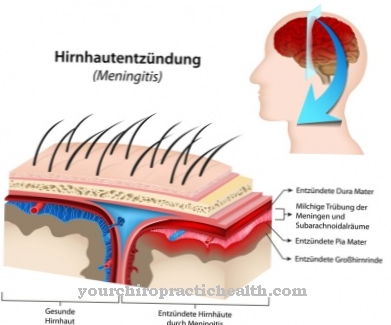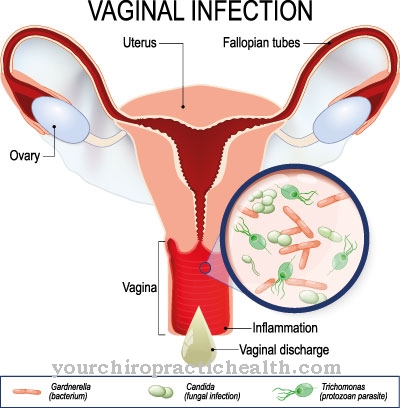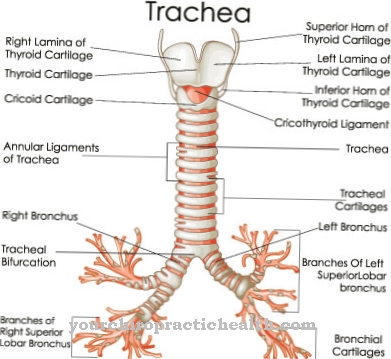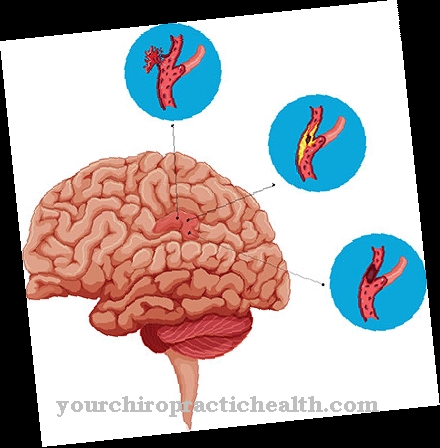Morquio's disease is a very rare metabolic disorder caused by an enzyme defect. As part of this disease, the breakdown of glycosaminoglycans is disturbed, which damages the affected tissue.
What is Morquio's disease?
Morquio's disease was first described in 1929 by the pediatrician Luis Morquio. It is a congenital metabolic disease, the cause of which is a defective protein. Depending on the defect, a distinction can be made between Morquio type A and Morquio type B disease.
causes
Morquio's disease is an inherited disease, whereby the inheritance is autosomal recessive. If mother and father have a faulty gene, this gene can be passed on to the child. As a result, the corresponding enzyme is not produced in the body and the child subsequently falls ill with Morquio's disease. Depending on the enzyme defect, a distinction is made between Morquio's disease type A and Morquio's disease type B.
In Morquio's disease type A, a 6-sulfatase defect occurs. As a result, the body's own glycosaminoglycans cannot be completely broken down and breakdown products are produced which are stored in lysosomes. In some cases there is also an increased excretion of these intermediate products, such as keratan sulfate in Morquio's disease type A or chondroitin-6 sulfate in Morquio's disease type B.
In addition, the decomposition products are stored in the liver, spleen, connective tissue, eyes and in the skeletal system, where they trigger functional disorders. They are only stored in connective tissue cells and not in the central nervous system, so that the patients have normal intelligence.
Symptoms, ailments & signs

© designua - stock.adobe.com
The severity of Morquio's disease varies; sometimes the disease is not diagnosed until adulthood due to the lack of symptoms. Typical symptoms are short stature with a very short neck, knock knees and corneal opacities. The intelligence of those affected is not reduced, nor are the liver and spleen enlarged.
Morquio's disease patients rarely reach a height of over 120 centimeters. The short stature is due to shortened long bones, which is often only noticeable in the fourth year of life. In addition, those affected have a keel chest, their joints are hypermobile and the face is reminiscent of gargoyles (gargoyles), so these changes are also referred to as gargoylism.
The chin is protruding and enlarged, the head is relatively large, and the cheeks are quite prominent. The bone changes that can be detected in the spine are also very noticeable. The vertebrae between the lumbar and thoracic spine often have the shape of a wedge, the vertebral bodies are relatively flat and the so-called deus axis (tooth extension of the second cervical vertebral body) is not properly fixed, which can lead to spinal canal stenosis or even cross-sectional symptoms.
The instability can also damage the spinal cord and lead to neurological deficits such as sensory disorders or paresis. Furthermore, the teeth often have defects in the tooth enamel, and very often inguinal and umbilical hernias, which make an operation necessary.
Diagnosis & course of disease
The diagnosis of Morquio's disease can be made through the detection of a high excretion of chondroitin sulfate or keratan sulfate. In addition, an X-ray examination of the ankles and wrists or the spine can be informative, as this usually reveals pronounced skeletal changes.
It is also possible to determine the activity of the defective enzyme in the fibroblasts or leukocytes. If there is a genetic change within the family, an examination can be carried out during pregnancy to determine whether the unborn child may have a disease.
Complications
With Morquio's disease, patients suffer from various malformations of the body. In most cases, so-called knock knees occur, which can lead to movement restrictions and thus to severe restrictions in everyday life. Corneal opacity also occurs and patients have a very short neck. However, the intelligence of the person concerned is not influenced by Morquio's disease. Furthermore, there is also a short stature.
This can mean bullying or depression, especially for children, as they are uncomfortable with their stature. The head is also often unusually large, which can lead to inferiority complexes or a reduced self-esteem. Furthermore, Morquio's disease can lead to paralysis or sensitivity disorders in the entire body, thereby significantly reducing the quality of life.
Various defects also occur on the teeth, which can make everyday life difficult. Treatment of Morquio's disease is symptomatic and aims to reduce the symptoms. In this way, infections of the respiratory tract can be avoided. Those affected are also dependent on taking medication and on physiotherapy. There are no particular complications in the treatment itself.
When should you go to the doctor?
The enzyme defect called "Morquio's disease" is an extremely rare, congenital metabolic disorder that is not a common occurrence. In addition, the associated symptoms sometimes only show up in adulthood. This often delays a visit to the doctor.
However, it is unusual that the massiveness of the symptoms does not lead to symptoms in some people with Morquio's disease. In most cases, this disease is unmistakable in view of the typical symptoms that occur, such as short stature in the range of 120 centimeters, a noticeably short neck or knock knees. The shape of the face also indicates an accompanying gargoyleism early on. A visit to the doctor also reveals massive skeletal changes.
The skeletal malformations associated with Morquio's disease require treatment. There is also an increased risk of anesthesia. This makes surgical interventions that serve to correct painful misalignments or restricted mobility more difficult. Apart from symptomatic treatment, there is little that medical professionals can do for those affected. New enzyme replacement therapies for patients with Morquio's disease are already being tested in some clinics.
Since the side effects of this illness often lead to inferiority complexes or bullying experiences, psychotherapeutic care should also be considered. Regular visits to the doctor or physiotherapeutic measures are inevitable with Morquio's disease. Visual and hearing impairments as well as immunological problems must be treated. Life expectancy can only be set at 50 years with appropriate medical treatment.
Therapy & Treatment
Treatment of Morquio's disease is mainly symptomatic (surgical interventions, prostheses, vertebral fusion to stabilize the neck), and enzyme replacement therapy is currently being tested. The provision of aids and physiotherapy also play an important role. Many children who suffer from Morquio's disease also often have hearing problems, so a hearing aid makes sense in some cases.
Acute bacterial infections are very often treated with antibiotics. To prevent respiratory infections, it is also advisable to remove tonsils and polyps. Thorough dental care is also important, as the tooth enamel is not very resistant. The opacity of the cornea usually does not impair vision, but those affected are often very sensitive to light, and tinted glasses can help here.
It is also important to perform an ultrasound scan of the heart at regular intervals, as storage material is also deposited in the heart muscle. Physiotherapy is advisable for problems in the skeletal system, as this can relieve pain and also delay joint stiffening. The strength of the joints can also be supported with special splints.
Comprehensive neurological examinations are also important in order to be able to identify possible complications in the area of the cervical spine in good time. In addition, patients with Morquio's disease should only be anesthetized by a very experienced doctor, as certain precautionary measures are required. The prognosis depends on the severity of the disease and the quality of treatment. With appropriate treatment, those affected usually reach an age of more than 50 years.
You can find your medication here
➔ Medicines for painOutlook & forecast
Morquio's disease is incurable. The prognosis is based on the symptoms and the time of the start of therapy. Affected children must be provided with the necessary aids at an early stage in order to avoid further damage and to improve the quality of life. For example, sick children can use tinted glasses to protect their light-sensitive eyes from the sun's rays. With comprehensive treatment, a life expectancy of over 50 years is possible.
The prospect of a symptom-free life exists if symptoms are treated comprehensively and no serious health complications such as respiratory infections occur. Regular ultrasound examinations of the heart can further improve the prognosis. Those affected also need therapeutic care in order to deal with the consequences of the disease. The sooner therapy is started, the better the prospects. Therefore, a doctor should be consulted at the first suspicion.
The extreme rarity of the disease can have a negative impact on the prognosis as the condition may not be diagnosed until late. Examinations by appropriate specialists for genetic changes are necessary in order to receive an early diagnosis and to initiate the treatment of Morquio's disease.
prevention
Since Morquio's disease is a hereditary disease, it cannot be prevented. In the case of an existing disease, however, it is possible to ensure treatment success through timely therapy. If there are already cases of Morquio's disease in the family, genetic counseling can be used if the family wishes to have children in order to better assess the risk.
Aftercare
Morquio's disease is a hereditary disease that is based on an enzyme defect. The disease is primarily treated symptomatically, as enzyme replacement therapy is currently still in the experimental stage. Therapy is therefore mostly limited to aids that are supposed to make everyday life more bearable for the patient. Prostheses must be precisely adjusted and replaced if necessary.
Dark tinted glasses and sunglasses protect sensitive eyes from strong light, while hearing aids improve the often increasing hearing loss.Thorough dental care is necessary, as in many cases with Morquio's disease, tooth enamel is not formed sufficiently. The extremely rare disease is often associated with social ostracism. Especially in childhood, patients suffer from teasing and bullying because of their malformations such as short stature, knock knees and unnatural head size.
The empathy of parents and other contact persons is particularly important here. Psychotherapeutic help is therefore recommended for both those affected and their relatives. Relaxation techniques such as yoga can also contribute to psychological stabilization and give new strength. Since Morquio's disease occurs very rarely, self-help groups are rarely found. The Society for Mucopolysaccharidoses provides more information on the disease.
You can do that yourself
If the child was born with Morquio's disease, the parents and other relatives are first challenged. Since enzyme replacement therapy is still in the experimental stage, Morquio's disease is treated symptomatically. Great adherence to therapy is important here.
Prostheses, for example, have to be precisely adapted and, if necessary, replaced and renewed. This also applies to other aids such as dark-tinted glasses and sunglasses to protect light-sensitive eyes, as well as hearing aids. Since Morquio's disease is often associated with insufficiently formed tooth enamel, regular, thorough dental care is important.
Morquio's disease is usually associated with short stature, knock knees and other malformations, especially on the head, which is why the children affected are often teased or even bullied. This gnaws at one's self-confidence and makes psychotherapeutic treatment recommended. The relatives should also seek psychotherapeutic support in order to meet the demands that a child with Morquio's disease places on them. Relaxation techniques such as yoga or Reiki bring balance and also give strength.
Because the disease is extremely rare, there is no corresponding self-help group in this country that those affected and their relatives could join. Because Morquio's disease is one of the mucopolysaccharidoses, the Society for Mukopolysaccharidoses e.V. also provides information about Morquio's disease (www.mps-ev.de/mps/mukopolysaccharidosen).
























.jpg)



